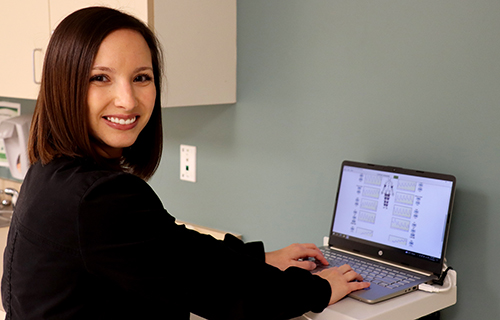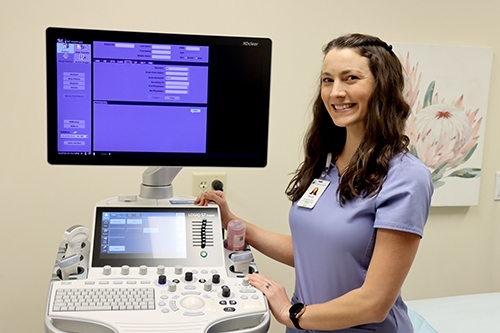What is vascular ultrasound?
Heart Health
St. Joseph’s/Candler Physician Network - Vascular Specialists has two dedicated ultrasound technologists in office to help diagnosis vascular disease
Swollen ankles? Redness around the skin? Cold feet or difficulty walking certain distances? Those are all signs of poor blood flow and a vascular ultrasound can help determine if you have any vascular conditions.

“A lot of times patients will see these manifestations of vascular disease, like swelling, and come in for an ultrasound and don’t understand why we are looking at the whole leg when the swelling is at their ankle,” says Kimberly Cook, one of two dedicated vascular ultrasound technologists at St. Joseph’s/Candler Vascular Specialists. “What we are looking for though is deeper inside that you can’t see. It could be a tiny little vein that the valve is not working and that is what is actually causing the symptoms that you do see.”
What is vascular ultrasound?
Ultrasound uses high-frequency sound waves to produce high-resolution images from within the body, describes Jessica Finney, the second dedicated ultrasound technologist at SJ/C Vascular Specialists. When it’s vascular ultrasound that means the technologists are looking at the veins and arteries anywhere from neck to toe.
Ultrasound doesn’t require contrast. It’s painless, often quick and efficient, Cook describes. A gel will be placed on the skin at the area the physician and technologist want to produce images. The gel works to fill in the air between the skin and the camera to help produce high-resolution images on the computer.

It depends on what the vascular team is looking for that determines how long the ultrasound will take. For example, if they are looking at the carotid artery (the arteries on both sides of your neck that supply blood to the brain) then it’s typically a 30-minute test, Finney says. But, if they are looking at the whole leg, or even both legs, it can be 60 to 90 minutes, she says.
Additionally, some tests may require you to stand for a certain length of time, so patients should be prepared for that.
Also, your physician may ask you to fast (not eat or drink anything) past midnight the day of your exam. This is almost a guarantee if you are having any blood vessels looked at within the abdomen, Cook says. That’s because bowel gas can obscure things that the ultrasound image may miss. Finney adds they try to schedule fasting patients in the morning.
What conditions are they looking for?
So what are they actually looking for when they take these images? There are a number of vascular conditions ultrasound can help diagnose. Here are a few:
- Venous insufficiency, or venous reflux, occurs when incompetent valves cause the backwards flow of blood in the veins in your legs. This condition can cause heavy, throbbing legs and spider and varicose veins. Learn more here.
- Narrowing of the arteries or blocked arteries that can cause redness of the skin, cold feet and/or difficulty walking certain distances without pain.
- Carotid artery disease, which is the build up of fatty deposits, calcium, fibrous tissue and other cell debris that lines the inside of the artery. This can reduce or block blood flow to the brain, leading to stroke. Learn more here.
- Abdominal aortic aneurysm is a bulging, weakened area of the wall of the aorta. A normal aortic diameter is two centimeters. Anything larger than three centimeters is considered an aneurysm. Learn more here.
Ultrasound also can be used for post-operative surveillance. For example, if you had a stent placed in a blood vessel, your surgeon may want it checked every six months or ever year to make sure it’s functioning properly.
How it benefits you being right there in the office
Not many vascular offices have dedicated ultrasound in practice, but it has so many benefits for the patient. One of the biggest ones is convenience.
“If a patient is here to see a nurse practitioner or one of the surgeons, and they feel an ultrasound is needed, we can do it right here,” Cook says.
“Or if it’s the opposite and they are here for ultrasound, then they can oftentimes go see the doctor afterwards to discuss the results,” Finney adds. “It’s not always doable, but if we can make it work, especially for those who travel long distances or have transportation issues, we try to accommodate them.”
Additionally, with the technologists in office, the physician can work directly with them to request the exact areas of the body they want to see images of. Working so closely with the surgeons, our technologists understand the protocols in place at SJ/C Vascular Specialists without having to send patients to an outside ultrasound tech.
If you are experiencing some of the symptoms of potential vascular disease, ask your primary care physician for a referral or reach out to our office here.